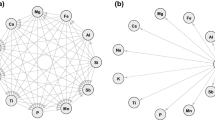Abstract
Given a compositional dataset in the absence of any prior information on any mixing process which may have formed it, a complete analysis of mixtures determines three distinct types of estimates in order. These are: (i) the estimate of the number of endmembers or fixed source compositions, of which all the sample compositions of the dataset must be approximate mixtures; (ii) the estimated compositions for each of these chosen number of endmembers; and (iii) the estimated contributions of each of these endmember estimates to each sample. Traditionally, the estimate for the number of endmembers has been assessed either by mapping or by inspection of the coefficients of determination between the observed and estimated variables. Mapping entails the plotting on a map of the region from which the samples were taken, either the contours of the contributions of each endmember to each sample, or some other portrayal of the distribution of endmember abundances. Because it requires the complete analysis, assessment by this method is too elaborate except for final confirmation and display. Alternatively, choosing a number of endmembers, which result in suitability high coefficients of determination for all or most variables, may account for elements which are not part of the conjectured mixing process or, worse, may result in the identification of endmembers which may never in fact have existed. Such an error is similar to overspecifying a multiple regression model. So, the obvious starting point from which to assess the validity, or otherwise choice of endmember numbers, is to examine the matrix of residuals. The differences between the logratio-transformed observed and estimated data form an array of residual logratios. A linear combination of these may be formed for each sample, which, under a random perturbation assumption, should follow a univariate normal distribution. Whether or not this scalar is normal can be readily tested. It can also be examined graphically for such desirable qualities as symmetry when the test for normality may be too severe. This procedure is employed to assess the decompositions of the U.S.G.S. Mid-Pacific data and the Nazca Plate Surface sediments.
Similar content being viewed by others
References
Aitchison, J., 1986,The Statistical Analysis of Compositional Data: Chapman and Hall, London and New York, 416 p.
Dymond, J., 1981, Geochemistry of Nazca Plate Surface Sediments: An Evaluation of Hydrothermal, Biogenic, Detrital, and Hydrogenous Sources: Geological Society of America Memoir v. 154, p. 133–173.
Imbrie, J., and Van Andel, T. H., 1964, Vector Analysis of Heavy-Mineral Data: Geological Society of America Bulletin, v. 75, p. 1131–1156.
Jöreskog, K. G., Klovan, J. E., and Reyment, R. A., 1976,Methods in Geomathematics, vol. 1, Geological Factor Analysis. Elsevier, Amsterdam, 178 p.
Lane, C. M., Manheim, F. T., Hathaway, J. C., and Ling, T. H., 1986,Station Maps of the World Ocean—Ferromanganese—Crust Data Base. Department of the interior, U.S. Geological Survey, Miscellaneous Field Studies Map, Map MF-1869, U.S. Geological Survey.
Leinen, M., 1987, The Origin of Paleochemical Signatures in North Pacific Pelagic Clays: Partitioning Experiments: Geochimica et Cosmochimica Acta, v. 51, p. 305–319.
Leinen, M., and Pisias, N., 1984, An Objective Technique for Determining End-Member Compositions and for Partitioning Sediments According to their Sources: Geochimica et Cosmochimica Acta, v. 48, p. 47–62.
Miesch, A. T., 1976, Q-Mode Factor Analysis of Geochemical and Petrologic Data Matrices with Constant Row Sums: Statistical Studies in Field Geochemistry, Geological Survey Professional Paper 574-G, U.S. Government Printing Office, Washington, 47 p.
Renner, R. M., 1988. On the resolution of Compositional Datasets into Convex Combinations of Extreme Vectors: Technical Report No. 88/02, Institute of Statistics and Operations Research, Victoria University of Wellington, Wellington, New Zealand, 49. p.
Renner, R. M., 1989, Comment on “Bediasite Source Materials: A Solution to an Endmember Mixing Problem Exploiting Closed Data“ by A. Woronow and K. M. Love: Geochimica et Cosmochimica Acta, v. 53, p. 1669–1670.
Renner, R. M., Glasby, G. P., Manheim, F. T. and Lane-Bostwick, C. M. 1989, A Partitioning Process for Geochemical Datasets, in F. P. Agterberg and G. F. Bonham-Carter (Eds.),Statistical Applications in the Earth Sciences: Geological Survey of Canada Paper 89-9, p. 319–328.
Author information
Authors and Affiliations
Additional information
This paper was presented at the 18th Geochautauqua, Newark, Delaware, 13–14 October 1989.
Rights and permissions
About this article
Cite this article
Renner, R.M. An examination of the use of the logratio transformation for the testing of endmember hypotheses. Math Geol 23, 549–563 (1991). https://doi.org/10.1007/BF02065806
Received:
Accepted:
Issue Date:
DOI: https://doi.org/10.1007/BF02065806




